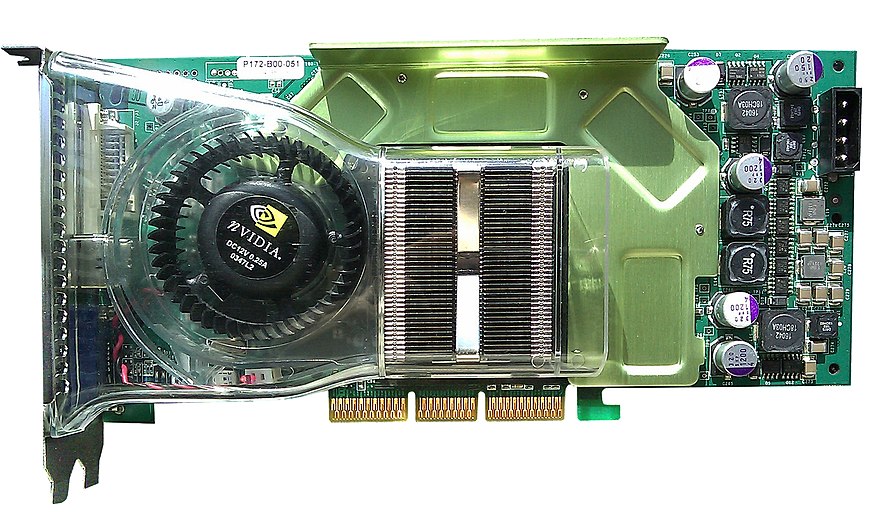ATI RADEON 9600 XT vs. NVIDIA GeForce FX 5700 Ultra: Best Performance | Game – Fall 2003: mainstream video adapters. ATI RADEON 9600 XT vs. NVIDIA GeForce FX 5700 Ultra
ATI RADEON 9600 XT vs. NVIDIA GeForce FX 5700 Ultra. Second part: Testing
Until recently, the main mid-range GPUs were the ATI RV350 and NVIDIA NV31. The former has been and continues to be used in the RADEON 9600 (PRO) series, the latter, respectively, in the GeForce FX 5600 (Ultra) series. Architecturally, the ATI RV350 is very similar to the R300, however, it has only four pixel pipelines and is manufactured using a 0.13-micron process technology, which allows reaching higher clock frequencies. NVIDIA NV31 descends from the infamous NV30. This VPU also carries four pipelines and is manufactured in a 0.13-micron process. Like NV30, NV31 can manage pipeline configuration and can operate either in 4×1 mode (pipelines x TMU) or in 2×2 mode.
Quite recently, the monsters of the graphics market, ATI Technologies and NVIDIA Corporation, decided to replenish their arsenals with new mainstream VPU models – RV360 – RADEON 9600 XT and NV36 – GeForce FX 5700, 5700 Ultra, respectively. It must be said that both additions are strictly positive in every sense:
The increase in the performance of mass VPUs had to be very appropriate, because soon we are expecting a whole legion of games using DirectX 9. Moreover, the emergence of new models will increase competition in the market, which will entail a slight decrease in prices for the previous generation products.
Announced now, graphics cards based on the new GPUs will be hyped up for Christmas with tweaked drivers and pre-Christmas discounts.
What awaits future buyers of video adapters based on RADEON 9600 XT and GeForce FX 5700/5700 Ultra chips? What have the graphic companies decided to pamper us with this time around? These and other questions will be answered by our today’s review.
RV360 and NV36 – what’s new? Part one: ATI RADEON 9600 XT
Looking at the technical characteristics of the RV360, one cannot help but notice that they are almost identical to those of its predecessor, the RV350 GPU. There are differences, but they are small and consist in a higher operating frequency and support for the Overdrive dynamic overclocking technology. Even outwardly, the chip looks exactly the same as its predecessor:.
Thanks to an improved manufacturing process that uses improved low-k dielectric insulation technology, ATI Technologies has achieved a 25% increase in frequency. Now the core RADEON 9600 XT, which will be the name of the new mid-range video adapters from ATI, operates at 500 MHz versus 400 MHz for the RADEON 9600 PRO. We will tell you a little later whether such an increase in the frequency will lead to a corresponding increase in performance, but for now let us take a closer look at one of our heroes in today’s review – the ATI RADEON 9600 XT video adapter.
Looking at it, we immediately got a strong feeling of déjà vu, because the video adapter was very similar to the RADEON 9600 PRO and … to the RADEON 9700 PRO! Take a look for yourself:
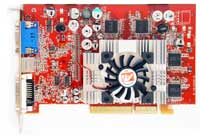
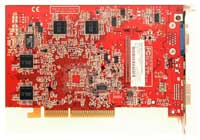
As you can see, a large rectangular radiator gives our hero some resemblance to the former flagship of the high-end line. However, unlike the latter, it is white and has a different fan. The increase in the cooling system as compared to the RADEON 9600 PRO is quite understandable – this is required by the clock frequency increased to 500 MHz. The radiator is fastened by means of two rather tight spring clips, and the usual yellow chewing gum is used as a thermal interface between its sole and the crystal surface. Perhaps it is not the most effective heat-conducting material, however, it copes with its task quite adequately, protecting the crystal from chips. The cooling fan makes almost no noise.
The rest of the PCB, except for small details, is identical to that used in the RADEON 9600 PRO, however, the number of elements on it is slightly less. Unfortunately, this time too, ATI Technologies engineers forgot to equip memory chips with heat sinks, the frequency of which, by the way, has not changed and is still 300 (600) MHz. Fortunately, they don’t heat up much. This video adapter uses Samsung chips with an access time of 3.3 nanoseconds. The relatively long access time does not allow us to hope for any acceptable overclocking. The total memory is 128 MB and the bus width is 128 bits. This card is a sample, therefore, it doesn’t make much sense to talk about the package bundle. It is also worth saying a few words about 2D quality. Up to a resolution of 1600x1200x85 Hz, the text on the monitor remained crystal clear;
ATI Overdrive: not in this version …
The essence of the ATI Overdrive dynamic overclocking technology is quite simple: the R360 and RV360 GPUs are equipped with a built-in thermal diode that reacts to changes in the core temperature; when it is low enough, the driver can increase its frequency to a certain value, reducing it when overheating. In the case of the RADEON 9600 XT, the core can operate at 500, 513 or 527 MHz, however, in the current version of Catalyst the Overdrive technology works only with RADEON 9800 XT cards. It is promised that the next version of these drivers will be able to use Overdrive on the RADEON 9600 XT as well.
RV360 and NV36 – what’s new? Part two: eVGA GeForce FX 5700 Ultra
The NVIDIA NV36 graphics processor is interesting, first of all, because it traces its ancestry from NV35, and not from NV31, as one might suppose. As a result of this approach, the new chip received the advantages that its older brother possesses. For example, according to NVIDIA, when executing pixel shaders, the GeForce FX 5700 Ultra performs calculations with 32-bit precision twice as fast as NV31. This is what the new GPU looks like:
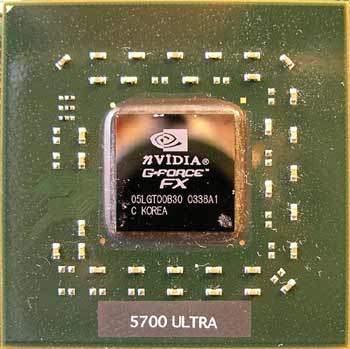
In fact, the NV36 is the NV35, which has been stripped of half of its pixel pipelines (or, more precisely, its programmable pixel processor has been “halved”) and a 256-bit memory bus. In our case, this chip is represented by the eVGA e-GeForce FX 5700 Ultra video adapter:
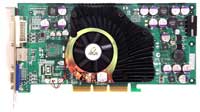
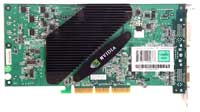
The video adapter looks very solid, thanks to the huge PCB and massive cooling system. The total weight of this product is about 360 grams, versus 200 grams for the RADEON 9600 XT, and most of it obviously falls on the cooling system.
A huge heatsink equipped with a fairly quiet fan cools not only the GPU, which runs at 475 MHz, but also Samsung’s GDDR2 memory chips with an access time of 2.2 nanoseconds, clocked at 450 (900) MHz.
Yes, you heard right – NVIDIA again used expensive and hot GDDR2 memory, as if forgetting about the bad experience with the GeForce FX 5800 Ultra. This step of the company is not entirely clear, because such a memory significantly increases the cost of the final product, and also heats up quite a lot. On the other hand, a relatively simple PCB can offset the cost of memory over time.
Moreover, one way or another, NVIDIA needs to implement new technologies in order to gain experience of effective mass production of devices with GDDR2. The total memory capacity of the GeForce FX 5700 Ultra is 128 MB.
The memory chips located on the back side of the PCB are covered with a passive heatsink. There you can also see an iron plate with the NVIDIA inscription, which strengthens the board and serves as an additional mount for the heatsink. The heatsink itself is secured with spring-loaded nuts that prevent it from crushing the VPU die.
The same yellow chewing gum is used as the thermal interface between the chip and the heatsink, as in the RADEON 9600 PRO, but the memory chips contact it through a layer of thermal paste deposited on some fibrous base. The rear part of the PCB responsible for powering the card and containing voltage converters is very similar to the PCB of the GeForce FX 5800 Ultra, otherwise the PCB is completely original. The power connector is well reinforced and even multiple plugging / unplugging of the power cable is unlikely to damage it.
Of greatest interest is the front part of the board, where you can see not only a footprint for installing a chip responsible for VIVO functions, but also a place for an additional TMDS. Why do you need it, since NV36 already contains a built-in TMDS transmitter?
The answer to this question is given by looking at the VGA connector. It is easy to see that the pin holes that are compatible with the DVI-I connector are clearly visible next to it. Thus, by installing an additional TMDS on the PCB, the manufacturer gets the opportunity to release a video adapter equipped with two digital outputs and ideally suited for use with two digital LCD panels. The 2D quality of this video adapter was also excellent, up to a resolution of 1600x1200x85 Hz.
eVGA GeForce FX 5700 Ultra Limited Edition as a Platform for Experiments
The new product under the name e-GeForce FX 5700 Ultra has arrived for our research, sparkling with a brand new box, made in traditional for NVIDIA black and green tones.
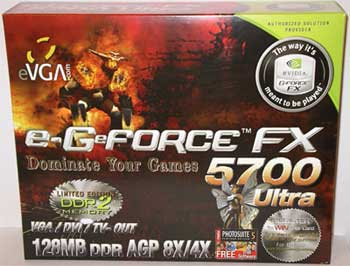
The belligerence of the product is emphasized by the graphics and inscriptions that adorn the box – in the upper left corner is a distant cousin of Barlog from “The Lord of the Rings”, and under the name of the product there is a proud inscription “Dominate Your Games”. The lower right corner was occupied by a winged elf Dusk in leather clothing, more reminiscent of the SS women from the RTCW than her closest relative, an innocent forest creature named Dawn. Above it is the traditional emblem “The way it’s meant to be played”, as well as the assurance that eVGA is the official supplier of solutions based on NVIDIA chips.
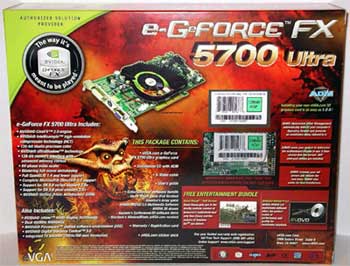
On the back of the box there is a small transparent window and a brief description of the eVGA e-GeForce FX 5700 Ultra video adapter. By the way, the box has the same dimensions as the box of the original ATI RADEON 9800 PRO.
We open the box, take out the protective plastic packaging from it and see the following items:

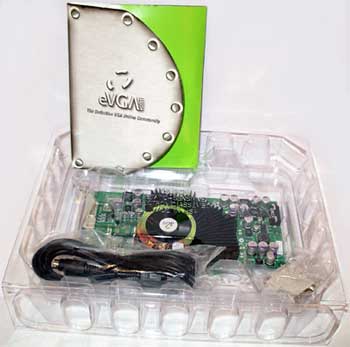
E-GeForce FX 5700 Ultra Video Adapter
User’s Guide
Warranty and Registration Cards
CD with Detonator 52.14 drivers
CD with NVDVD player
CD with demos, utilities and demo version of America’s Army game
CD with full version of Tom Clancy’s Ghost Recon
Two branded PC case stickers (with eVGA logo)
DVI-I to D-Sub adapter
S-Video cable
On one of the box valves there is a curious inscription, suggesting that the buyer does not return the video adapter to the store in case of failure, but, instead, contact the eVGA warranty department.
RV360 and NV36 – what’s new? Part three: comparative characteristics of new products
So what’s new for us with the new mid-range GPUs? The answer can easily be found in the comparison table below:
| Name the video adapter | ATI Radeon 9600 PRO | ATI Radeon 9600 XT | NVIDIA GeForce FX 5600 Ultra | NVIDIA GeForce FX 5700 Ultra |
|---|---|---|---|---|
| VPU name | RV350 | RV360 | NV31 | NV36 |
| Technical process | 0.13-μm | 0.13-мкм low-k | 0.13-μm | 0.13-μm |
| Number of transistors | ~ 75 million | ~ 75 million | ~ 80 million | ~ 82 million |
| Memory bus | 128 bit DDR | 128 bit DDR | 128 bit DDR | 128 bit DDR-II |
| Filling speed, Gpix / sec. | 1,6 | 2 | 1,6 | 1,9 |
| Vertex processing speed, mln. Vertices / sec. | 200 | 250 | 100 | 356 |
| AGP Modes | 4x/8x | 4x/8x | 4x/8x | 4x/8x |
| VPU frequency | 400 MHz | 500 MHz | 400 MHz | 475 MHz |
| Memory frequency | 600 MHz DDR | 600 MHz DDR | 800 MHz DDR | 900 MHz DDR |
| Number of pipelines / TMU | 4×1 | 4×1 | 4×1/2×2 | 4×1/2×2 |
| Pixel / Vertex Shader Version | 2.0/2.0 | 2.0/2.0 | 2.0+/2.0+ | 2.0+/2.0+ |
| Max. FSAA Multisampled / Mixed mode | 6x | 6x | 4x/8x | 4x/8x |
| Max. Anisotropic filtering mode | 16x | 16x | 8x | 8x |
| Supported technologies | Hyper Z III+, SmartShader 2.0, SmoothVision 2.1 | Hyper Z III+, SmartShader 2.0, SmoothVision 2.1 | IntelliSample, CineFX | IntelliSample, CineFX 2.0 |
| RAMDAC number / frequency | 2×400 MHz | 2×400 MHz | 2×400 MHz | 2×400 MHz |
| TMDS | there is | there is | there is | there is |
| TV out support | there is | there is | there is | there is |
The NV36 boasts the largest number of innovations. Especially impressive is the more than tripled vertex processing speed, as well as the frequencies at which the core and memory operate. However, will it be enough to become a winner?
About testing methods and test platform
Since both of the above GPUs are new, we could not resist examining their performance in detail in a number of theoretical tests.
A system with the following configuration was used as a system platform:
Processor: AMD Athlon XP 3200+ “Barton” (2.2 GHz, 400 MHz FSB);
Motherboard: ABIT NF7-S v2.0;
RAM: 512 MB PC3200 (2×256 MB, 2-3-3-6, 400 MHz, Corsair XMS3200);
Hard drive: Maxtor DiamondMax Plus D740X (2 MB buffer), 40 GB capacity;
Sound adapter: NVIDIA MCP-T;
OS: Microsoft Windows XP SP1;
Drivers: ATI Catalyst 3.8, NVIDIA ForceWare 52.16.
Quality settings in control panels of ATI and NVIDIA drivers were set to “Quality”.
The new NVIDIA ForceWare 52.16 drivers deserve a special mention. The fact is that this version of the drivers, in fact, elevated the “optimizations” of the shader code to the official rank. Let us explain: NVIDIA has integrated an optimizing code translator into ForceWare (see details in the review of NVIDIA GeForce FX 5950 Ultra and ATI RADEON 9800 XT ), which can potentially significantly increase the execution speed of DirectX9 pixel shaders. Let’s move on, however, to the theoretical part of our testing … Autumn 2003: mass video adapters. ATI RADEON 9600 XT vs. NVIDIA GeForce FX 5700 Ultra ATI RADEON 9600 XT vs. NVIDIA GeForce FX 5700 Ultra. Second part: Testing





